Month 1:15 (Aviv), Week 2:7 (Shibi'i/Sukkot), Year 5935:015 AM
CHAG HA-MATZAH (Unleavened Bread) ANNUAL MOED 2:1
Gregorian Calendar: Monday 18 [Red] April 2011
Chag haMatzah
Finding Your Place in Middle Mem
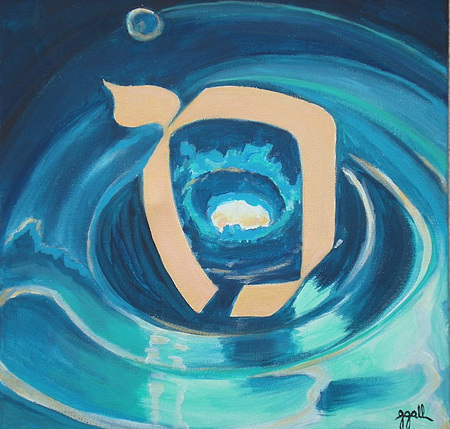
"Seven days you shall eat unleavened bread (matzah). On the first day you shall remove leaven (chametz) from your houses. For whoever eats leavened bread from the first day until the seventh day, that person shall be cut off from Israel ... Remember this day in which you went out of Egypt, out of the house of bondage; for by strength of hand Yahweh brought you out of this place. No leavened bread (lechem with chametz) shall be eaten. On this day you are going out, in the month Aviv. And it shall be, when Yahweh brings you into the land of the Canaanites and the Hittites and the Amorites and the Hivites and the Jebusites, which He swore to your fathers to give you, a land flowing with milk and honey, that you shall keep this service in this month. Seven days you shall eat unleavened bread (matzah), and on the seventh day there shall be a feast to Yahweh. Unleavened bread (matzah) shall be eaten seven days. And no leavened bread (lechem with chametz) shall be seen among you, nor shall leaven (chametz) be seen among you in all your quarters. And you shall tell your son in that day, saying, 'This is done because of what Yahweh did for me when I came up from Egypt'" (Ex.12:15; 13:3-9, NKJV).
Shabbat shalom kol beit Yisra'el! Welcome to the first day of the second annual festival of Chag haMatzah also know as the Feast of Unleavened Bread. For the next seven days we shall be eating lechem (bread) without chametz (leaven) and for the next seven days I will be telling you why as we search the deep mysteries of our Elohim's lev (heart).
Now we all know the exoteric, p'shat or literal, plain sense of why we eat matzah bread during this special season. It was because there wasn't time for the Israelites to make ordinary leavened bread. They had to leave Egypt in a hurry. In eating unleavened bread we remind ourselves that when it comes to Egypt, the world, Babylon and sin, we are to not only leave these behind but to leave them as quickly as possible. We should never delay when it comes to dealing with sin issues because the longer we allow ourselves to remain in sin's camp, the more sin-leavening can take place in us. If you want to quit alcohol, don't hang around bars or pubs where there's a greater chance of your succumbing to the temptation of liquor again. The bar or pub is the leaven house of sin. Leave the environment of sin and then sin will no longer so readily touch you.
Ideally we should, upon being converted to Yah'shua, quit a life of sin wholesale - pack up our bags and leave completely and forever, burning all bridges behind us. That is what we are called to do. The sad reality is that most people cling on to some sinning and na´vely suppose that it won't have much of an affect on them. Those amongst the camp of Israel who periodically rose up in rebellion against Yahweh and His Prophet Moses are a sober reminder that sin is ever lurking and that we must not only quit sinning but create an ever widening distance between sin and ourselves.
For Abraham, it meant a complete change of location and lifestyle. He had his 'exodus' too. He left behind everything he knew as a successful businessman in the metropolis of Ur of the Chaldees and started afresh in a new land living the simple life of a nomad dealing in cattle. He became rich again but this time in a new way and in his own cultivated, Yahweh-centred environment. And as we know from the testimony of the Bible he was living pretty much the same lifestyle as the Israelites who came after him would live:
"Abraham obeyed My voice and kept My charge, My commandments, My statutes, and My laws" (Gen.26:5, NKJV).
He kept the whole Torah long before Moses was commanded to write it down in the form we have in the Pentateuch, the first five books of the Bible. He wasn't living a Torah lifestyle in Mesopotamia and probably would have found it very difficult, so Yahweh relocated Him to a place where he could.
Every man and woman needs to be living in a place, hand-picked by Yahweh, where he can obey His voice, keep His charge, obey and keep His commandments, statutes and laws in Messiah Yah'shua (Christ Jesus). For every family that place must be shown by personal revelation to the Rosh of Head of that family. It may not be a permanent location for we, too, in difficult times, may need to learn to be 'nomads' of sorts. Like the oases in the desert of the Israelites' wanderings and afflictions, we must move with the pillar of fire by night and the cloud of covering by day. We are not permanently settled here for we have our citizenship in heaven (Phil.3:20), not on earth. With that view in mind, we should not get too attached to the bits of land we settled on in case it is time to move on. And when the Final Gathering takes place, it will mean that the next stop will be permanent!
We celebrate Chag haMatzah for seven days precisely because there is a lot to learn and do. This seven-day Festival of Yahweh is mirrored by one other seven-day festival which comes at the end of the cycle of moedim or appointments at Sukkot. Both are feast times but they are very different from each other for two main reasons:
- 1. The first is about the journey to our destination; and
- 2. The second is what we do when we reach our destination.
This seven day period is to remind us that we have a whole life ahead to get things right. It's the time we work hard to get all sin (as represented by chametz or leaven) out of our life. The last seven-day period is a festival for those who have successfully got all that sin out of their lives and can present themselves as a spotless allegorical Bride for the Messiah. This seven days is about work and the last even days is about celebration. And yes, it is true to say that this seven days is partly about celebration - about being delivered from Egypt - but at the same time we have to remember that getting out of Egypt isn't all there is to do for we are on a three-stage journey:
- 1. Getting out of Egypt;
- 2. Staying out of Egypt and moving farther and farther away; and
- 3. Arriving at the Promised Land
The hardest part is the middle or second part - the Mem (m) part of our journey that leads to Shavu'ot where we covenant to obey all the mitzvot or commandments. And do you remember what the letter mem (m) represents in our body and in the festivals? The Way of Abba Yahweh will hopefully refresh your memories - for here we see how the festivals are a detailed map of our spiritual journey through life:
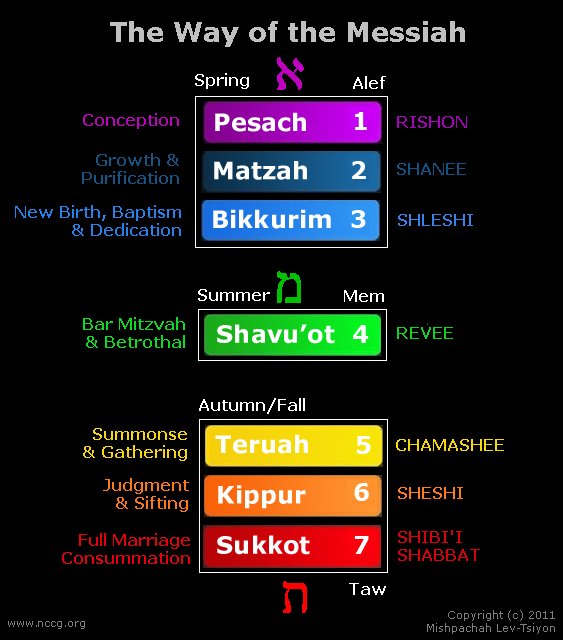
At Chag haMatzah Day #1 we are in the growth stage, still in our mother's womb, though very soon - tommorow, in fact, we will be 'born' at Yom haBikkurim. The feast of Chag haMatzah actually continues beyond Yom haBikkurim because it still applies to the rest of our life after being born again! We may be pointing toward heaven after the New Birth but we aren't there until we have completed our life here on earth, having remained true, growing degree by degree - line upon line - until we have fully overcome.
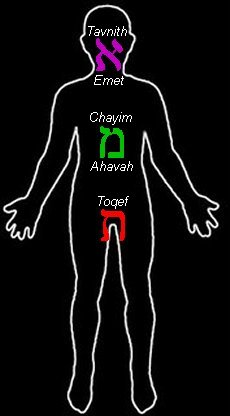 The growing that takes place in our mother's womb is beyond our complete control. Curled up as a little embryo in a small water-filled sack, there isn't really a lot we can do, is there? That period of time is one of grace for as mother takes care of her body, making sure she doesn't poison her unborn child with tobacco, drugs, alcohol, stress or a lack of ahavah (love), so in this part of our spiritual growth we can do absolutely nothing at all: Yahweh watches over us through the mothering of the Ruach haQodesh (Holy Spirit). All we have to do is wait. On the Chag haMatzah scale, this represents one of the seven days only. On the second we are "born again" (John 3:1-21) and for the remaining five we have to struggle through the rest of life until we make it to the Heavenly Wedding!
The growing that takes place in our mother's womb is beyond our complete control. Curled up as a little embryo in a small water-filled sack, there isn't really a lot we can do, is there? That period of time is one of grace for as mother takes care of her body, making sure she doesn't poison her unborn child with tobacco, drugs, alcohol, stress or a lack of ahavah (love), so in this part of our spiritual growth we can do absolutely nothing at all: Yahweh watches over us through the mothering of the Ruach haQodesh (Holy Spirit). All we have to do is wait. On the Chag haMatzah scale, this represents one of the seven days only. On the second we are "born again" (John 3:1-21) and for the remaining five we have to struggle through the rest of life until we make it to the Heavenly Wedding!
Inside the womb we physically grow by a foreordained tavnith or pattern. In the second diagram you will see this represents the Alef (a) of our being, corresponding to the head. The absolute Alef (a) of the festivals is Pesach or Passover which we celebrated yesterday where we learned about the Pesach-child and the foundation of our being. Out of the mouths of babes is basic emet (truth) learned!
The Mem (m) of our journey corresponds to our lev or heart. And the heart, I am sure you will agree, is a most unruly thing. For our safetly, you will see from the diagram that Yahweh has sandwiched it betweem Alef (a) and Taw (t), the Beginning and the End, representing the tavnith or pattern of emet (truth) and toqef or authority, respectively. During the Ten Plagues, Yahweh demonstrated, beyond controversy, His toqef (authority) over us. Without emet-tavnith (Truth-Pattern) and Toqef (Authority) the lev (heart) will always lead us into chaos. Yahweh warns through the prophet Jeremiah:
"The lev (heart) is deceitful above all things, and desperately wicked; who can know it? I, Yahweh, search the lev (heart), I test the mind, even to give every man according to his ways, according to the fruit of his doings" (Jer.17:9-10, NKJV).
The lev or heart has its place in the middle, sandwiched between the Alef (a) and Taw (t) without which it would career over the cliffs of lawlessness and down to its death. Who is the Alef (a) and Taw (t)? It is Yah'shua our Messiah (Jesus Christ) and we are the Mem (m)! In the same way a husband is the Alef (a) and Taw (t) and the wife is the Mem (m) in a marriage. The purpose of Chag haMatzah is to make sure that we are properly suspended between the Alef (a) and Taw (t), the very Creator of who we are!
This vital emet or truth is sadly lost in a vitally important Bible passage in our English Bible translations, right in Genesis 1:1 where it reads in the Hebrew:
In English this should read:
"In the beginning Elohim (God) Alef (a)-Taw (t) created the heavens and the earth" (Gen.1:1, NKJV).
Almost every English translation drops the Alef (a)-Taw (t) letters because most translators don't know what to do with them. But they represent Messiah, Yah'shua (Jesus), who is the derech (way), the emet (truth) and the chayim (life) (Jn.14:6) and we are supposed to be hidden inside Him - between the Alef (a) and the Taw (t) as His Mem (m), walking in correct tavnith (pattern) and under his toqef (authority). The Ten Plagues were a demonstration of that authority and of the futility of trying to live outside of it, even as Korah and other rebels later found out during their Chag haMatzah wandering.
The lev or heart is vital to chayim (life) and to ahavah (love) but unless it is positioned correctly between the Alef (a) and Taw (t) of emet-tavnith (love and pattern) and toqef (authority) it will wander in sin and be destroyed. These two are our hedges of protection. Mess with them and life becomes chaos.
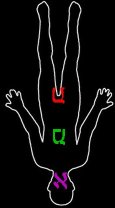 Consider those churches, organisations, political systems and religions which turn everything on its head by making toqef (authority) the 'main thing' - the Catholics and Mormons, to give two examples. Virtually all political systems, but especially totalitarian ones like communism and fascism, are established on the basis of these topsy-turvy relationships. Islam too. Systems that are ruled by toqef (authority) over emet (truth) are always Torahless, oppressive and perverse.
Consider those churches, organisations, political systems and religions which turn everything on its head by making toqef (authority) the 'main thing' - the Catholics and Mormons, to give two examples. Virtually all political systems, but especially totalitarian ones like communism and fascism, are established on the basis of these topsy-turvy relationships. Islam too. Systems that are ruled by toqef (authority) over emet (truth) are always Torahless, oppressive and perverse.
"Yahweh will make you the head and not the tail; you shall be above only, and not be beneath, if you heed the commandments of Yahweh your Elohim, which I command you today, and are careful to observe them" (Deut.28:13, NKJV).
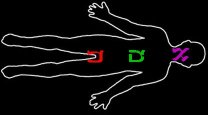 Those systems which are not 'upside down' tend towards the overturning of hierarchy and render everything 'equal'. This is like laying the body on its side. Every man can pick and choose his own toqef (authority) and emet (truth). And indeed most do just that today, repeating the situation that obtained at the end of the period of Judges, when "everyone did what was right in his own eyes" (Judg.21:25, ISRV).
Those systems which are not 'upside down' tend towards the overturning of hierarchy and render everything 'equal'. This is like laying the body on its side. Every man can pick and choose his own toqef (authority) and emet (truth). And indeed most do just that today, repeating the situation that obtained at the end of the period of Judges, when "everyone did what was right in his own eyes" (Judg.21:25, ISRV).
The Chag haMatzah journey is our journey to our lev (heart) by following Yahweh's true Order. This is what we shall be talking about over the next six days. I hope you will return with me as we do that and in so doing gain a complete picture of the purpose of this wonderful festival.
Have a blessed Chag haMatzah!
Continued in Part 2
 Share
Share
|


